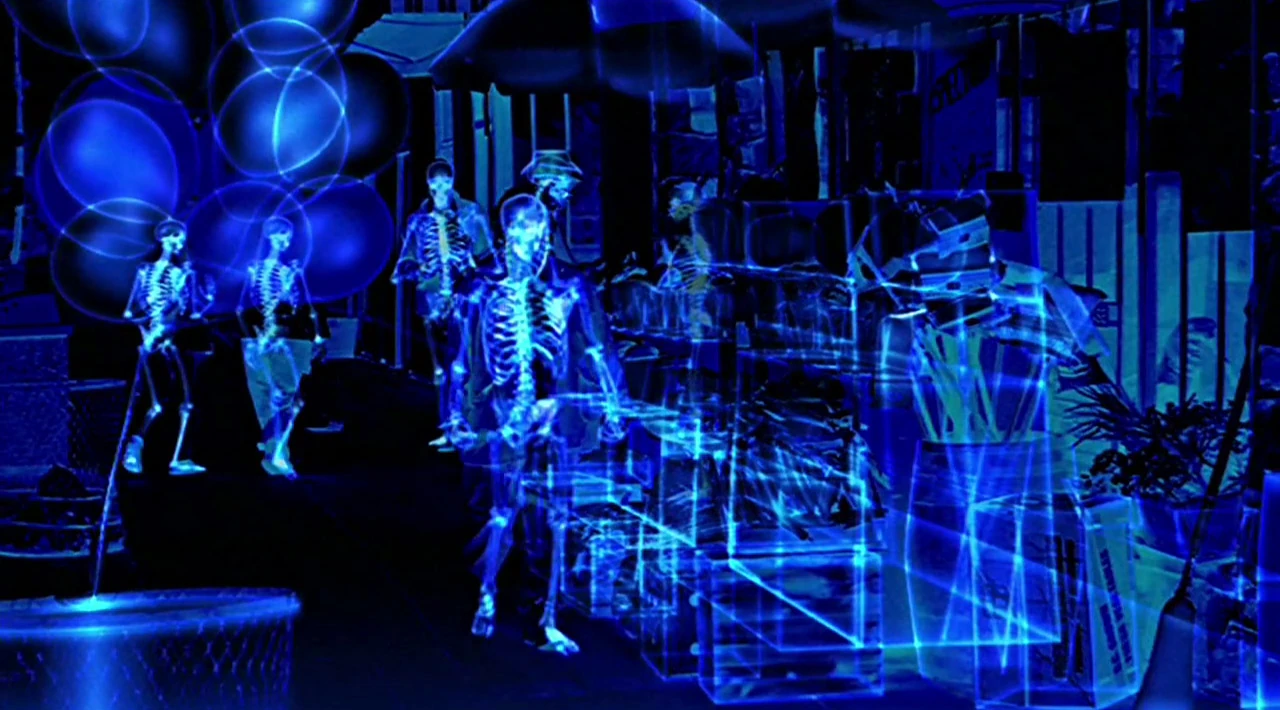ZAP
A few years ago, we heard tales of vans outfitted by the U.S. government to hold giant X-ray scanners, which they'd use to drive around and inspect vehicles.
Now, it turns out similar vans have made their way to police departments, including the NYPD. The police are unwilling to explain (PDF) how they're used, or how often.
"A state court has already ruled that the NYPD has to turn over policies, procedures, and training manuals that shape uses of X-rays; reports on past deployments; information on the costs of the X-ray devices and the number of vans purchased; and information on the health and safety effects of the technology.
But New York City is fighting on appeal to suppress that information and more, as if it is some kind of spy agency rather than a municipal police department operating on domestic soil, ostensibly at the pleasure of city residents."
***
 |
| NO SURFING! |
I expect we will soon enough start hearing about surfers on the Pacific Coast getting cancer...
Japan's labor ministry has confirmed the first cancer case related to work at the Fukushima Daiichi nuclear plant. Following on from reports of elevated levels of child cancer and 1,600 civilians deaths from the evacuation, this is the first time that one of the 44,000 people involved in the clean up operation has been diagnosed with cancer resulting directly from the accident.
The worker was involved in recovery and cleanup efforts at the plant after it suffered a meltdown in March, 2011. He was in his late 30s at the time, and has been diagnosed with leukemia.
The ministry has approved workers' compensation. Radiation exposure has been linked to the onset of leukemia.
Seth Baum, executive director of the Global Catastrophic Risk Institute, writes in the Bulletin of the Atomic Scientists that Japan should restart more of its nuclear reactors (the Sendai nuclear plant was restarted in August).
The reason is simple, writes Baum:
"Japan is now building 45 new coal power plants, but if it turned its nuclear power plants back on... it could cut coal consumption in half. And coal poses more health and climate change dangers than nuclear power."
Ya Right!
Tell it to the surfers who are now surfing in radioactive waters of the Pacific thanks to Japan!
Don't believe me? Take a geiger counter
to the ocean and check it out for yourself.
When surfing, water invariably ends up in the nasal cavities close to the brain, now that salt water is radioactive!
***
In Back to the Future Part II, Marty McFly travels from 1985 to today — October 21, 2015.
The movie predicts a World Series victory for the Chicago Cubs, something they haven't managed since 1908. The Cubs actually did make the playoffs this year, and are fighting for a league championship title at the moment of this writing.
http://backintimefilm.com/
***
Modern crapification of the earth literally
Or
Oops the ship sunk with the dirt in the middle of the Pacific Ocean...O Darn.
Rafael Minder writes in the NY Times that almost 50 years after coming close to possibly provoking a nuclear disaster, Secretary of State John Kerry, following years of wrangling between Spain and the U.S., signed an agreement to remove contaminated soil from an area in southern Spain where an American warplane accidentally dropped hydrogen bombs.
In 1966 a bomber collided with a refueling tanker in midair and dropped four hydrogen bombs, two of which released plutonium into the atmosphere. No warheads detonated, narrowly averting what could have been an explosion more powerful than the atomic strikes against Japan at the end of World War II.
Four days after the accident, the Spanish government stated that "the Palomares incident was evidence of the dangers created by NATO's use of the Gibraltar airstrip," announcing that NATO aircraft would no longer be permitted to fly over Spanish territory either to or from Gibraltar.
The U.S. later announced that it would no longer fly over Spain with nuclear weapons, and the Spanish government formally banned U.S. flights over its territory that carried such weapons.
Neither Kerry nor Spanish Foreign Minister García-Margallo said exactly how much contaminated soil would be sent back, where it would be stored in the United States, or who would pay for the cleanup — some of the issues that have held up a deal until now.
Spain has insisted that any contaminated soil be sent to the United States, because Spain does not have plants to store it.
Concern over the site was reawakened in the 1990s when tests revealed high levels of americium, an isotope of plutonium, and further tests showed that 50,000 cubic meters of earth were still contaminated.
The Spanish government appropriated the land in 2003 to prevent it being used.
***
Transmitting power through the air using sound above the range of human hearing: that's the gist of ultrasonic power transfer.
The promise is that you can sit in a coffee shop and use your phone like normal while it's recharged by invisible waves of energy.
That's a future we all want — and one that uBeam has been promoting, but hasn't backed it up with proof.
Physics is a cruel mistress, and this is no exception.
Using the data found in uBeam's patent filings you can see that ultrasonic power transfer is a brutal engineering challenge.
It's probably not impossible, but looking at what it would take for a widespread rollout of the tech makes it highly improbable.
I think it is possible in the distant future.
 Speaking of sound...
Speaking of sound... Elephants use infrasound to communicate very long distances at night.
***
I lived in my van for a while during the hippy days.

A little over a year ago, Google employees on a Quora thread announced they'd discovered an interesting way to live in the ultra-expensive Bay Area:
Rather than pay for conventional housing, they resided in trucks and RVs parked near (or on) the company's campus, and took advantage of corporate perks—including free food, gym facilities, and dry cleaning—to get by on a day-by-day basis.
Now one Googler, Brandon S., has taken to his blog to describe how he engaged in a little off-grid living within sight of Google's high-tech headquarters.
First he spent $10,000 of his Google signing bonus on a 2006 Ford truck with 128 square feet of room in the back, which he filled with a bed, dresser, and coat rack.
Google pays for his phone, and he uses the company's gym and cafeterias to eat and shower.
For those Bay Area tech pros who think Brandon's lifestyle sounds appealing, his list of drawbacks includes "social suicide," the inconvenience of not having a bathroom or fridge in close proximity, stress, insect infestations, and the upfront costs of purchasing a large-enough vehicle.
On the other hand, he's also using the cash savings to rapidly pay down his student loans.
***
 Your new card with the little metal looking chip is not as good at being secure as they would like you to think...
Your new card with the little metal looking chip is not as good at being secure as they would like you to think...
When in 2010 a team of computer scientists at Cambridge University demonstrated how the chip and PIN system used on many modern payment cards can be bypassed by making the POS system accept any PIN as valid, the reaction of the EMVCo and the UK Cards Association was to brand the attack as "improbable." After all, the researchers used a bulky tech setup that had to be carried around in a backpack but, as it ultimately turned out, a year later an engineer based in France found a less obvious way to perform the attack.
***
None Such
Veproject1 has uploaded nearly 100 videos, almost all of which show the workings of machines that can't possibly exist.
The creator of these machines — Valeriy Ivanov — is a Ukrainian engineer living in Canada.
According to his website, the purpose of these contraptions is, "to attract youth to Engineering and Science... [so they] can discuss basic scientific principles upon which they are built."
In
order of likeliness:
Maybe they're meant to be illustrative?
Maybe Mr.
Ivanov thinks perpetual motion is possible and wants to spread his
wisdom?
Or maybe he's a huge troll with the patience to film tons of
short videos and maintain a website and Facebook page under an alias?
Regardless
of why these videos exist, the real fun lies in watching YouTube
commenters suss out how the fakes were built to look as though they're
functioning.
It's just plain fun!
It's just plain fun!
***
The space tether experiment, a joint venture of the US and Italy, called for a scientific payload--a large, spherical satellite--to be deployed from the US space shuttle at the end of a conducting cable (tether) 20 km (12.5 miles) long.
The idea was to let the shuttle drag the tether across the Earth's magnetic field, producing one part of a dynamo circuit. The return current, from the shuttle to the payload, would flow in the Earth's ionosphere, which also conducted electricity, even though not as well as the wire.
The full story is not being told in the above link.
And for good reason!
 Most people will not believe what actually took place.
Most people will not believe what actually took place.There was a very large amount of unidentified flying objects that appeared around the cable as it drifted away from the space shuttle.
A man up in Canada named Martyn Stubbs had the incredible opportunity and the proper equipment to intercept NASA's actual visual communications concerning the tether experiment.
He made a video he titled "The Smoking Gun" in 2001 about his findings.
The video is called the most popular underground tape among astronauts, and it claims to show video evidence of aliens in space.
There's allegedly some form of intelligent life flying around on the NASA videos.
Curious anomalous objects can be seen swarming around the tether.
Here is that video:



No comments:
Post a Comment